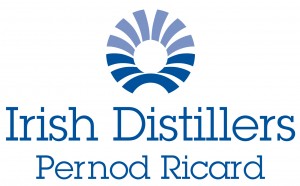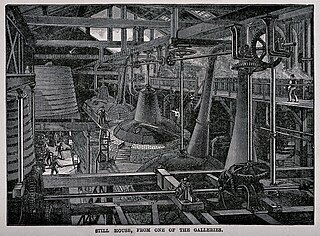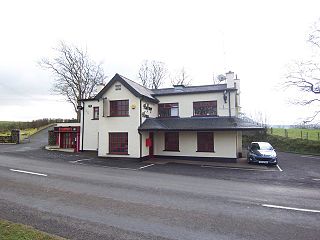
Columba or Colmcille was an Irish abbot and missionary evangelist credited with spreading Christianity in what is today Scotland at the start of the Hiberno-Scottish mission. He founded the important abbey on Iona, which became a dominant religious and political institution in the region for centuries. He is the patron saint of Derry. He was highly regarded by both the Gaels of Dál Riata and the Picts, and is remembered today as a Catholic saint and one of the Twelve Apostles of Ireland.

Whisky or whiskey is a type of liquor made from fermented grain mash. Various grains are used for different varieties, including barley, corn, rye, and wheat. Whisky is typically aged in wooden casks, which are typically made of charred white oak. Uncharred white oak casks previously used for the aging of port, rum or sherry are also sometimes used.

County Antrim is one of six counties of Northern Ireland and one of the thirty-two counties of Ireland. Adjoined to the north-east shore of Lough Neagh, the county covers an area of 3,086 square kilometres (1,192 sq mi) and has a population of 651,321, as of the 2021 census. County Antrim has a population density of 203 people per square kilometre or 526 people per square mile. It is also one of the thirty-two traditional counties of Ireland, as well as part of the historic province of Ulster.

Irish whiskey is whiskey made on the island of Ireland. The word 'whiskey' comes from the Irish uisce beatha, meaning water of life. Irish whiskey was once the most popular spirit in the world, though a long period of decline from the late 19th century onwards greatly damaged the industry, so much so that although Ireland boasted at least 28 distilleries in the 1890s, by 1966 this number had fallen to just two, and by 1972 the remaining distilleries, Bushmills Distillery and Old Midleton Distillery, were owned by just one company, Irish Distillers.

Bushmills is a village on the north coast of County Antrim, Northern Ireland. Bushmills had a population of 1,295 in the 2011 Census. It is located 60 miles (97 km) from Belfast, 11 miles (18 km) from Ballycastle and 9 miles (14 km) from Coleraine. The village owes its name to the River Bush and to a large watermill that was built there in the early 17th century. It is home to the Old Bushmills Distillery, which produces Irish whiskey, and is near the Giant's Causeway.

Broughshane is a large village in County Antrim, Northern Ireland. It is 3.5 miles (5.6 km) northeast of Ballymena and 13.8 miles (22.2 km) north of Antrim, on the A42 road. It is part of Mid and East Antrim District Council and had a population of 2,879 people in the 2011 Census.

Ballymena is a town in County Antrim, Northern Ireland. It had a population of 29,551 people at the 2011 Census, making it the eighth largest town in Northern Ireland by population. It is part of the Borough of Mid and East Antrim.

The Old Bushmills Distillery is an alcohol distillery in Bushmills, County Antrim, Northern Ireland, owned by Proximo Spirits. Bushmills Distillery uses water drawn from Saint Columb's Rill, which is a tributary of the River Bush. The distillery is a popular tourist attraction, with around 120,000 visitors per year. It produces the Bushmills brand of Irish whiskey.

Slemish, historically called Slieve Mish, is a hill in County Antrim, Northern Ireland. It lies a few miles east of Ballymena, in the townland of Carnstroan. Tradition holds that Saint Patrick, enslaved as a youth, was brought to this area and tended sheep herds on Slemish, and that during this time he found God.

Irish Distillers is a subsidiary of the French drinks conglomerate Pernod Ricard. It is the largest distiller of Irish whiskey, distilling popular brands such as Jameson and Powers, in addition to premium whiskeys such as Redbreast and Midleton Very Rare. In addition to whiskey, Irish Distillers also produces a number of other spirit products such as gin and vodka.
All Saints Gaelic Athletic Club is the only Gaelic Athletic Association club in the town of Ballymena, County Antrim. The club is a member of the South-West Antrim division of Antrim GAA, and competes in Gaelic football, hurling, Ladies Gaelic football and camogie.
Events from the year 1608 in Ireland.

The River Bush is a river in County Antrim, Northern Ireland. The River Bush is 33.5 miles (53.9 km) long. The river's source is in the Antrim Hills at 480m. From there the river flows northwest, with a bend at the town of Armoy. It then flows west, passing through Stranocum, and then bends north, passing through Bushmills before reaching the sea at Portballintrae on the North Antrim coast. It flows through a fertile valley devoted to grassland-based agriculture with limited arable cropping. The underlying geology is basalt and the water is slightly alkaline with magnesium making an unusually large contribution to total hardness. The river supports indigenous stocks of Atlantic salmon and brown trout. Saint Columb's Rill, which is a tributary of the river, is the source of water used for distilling Bushmills whiskey.

The following outline is provided as an overview of and topical guide to whisky:












